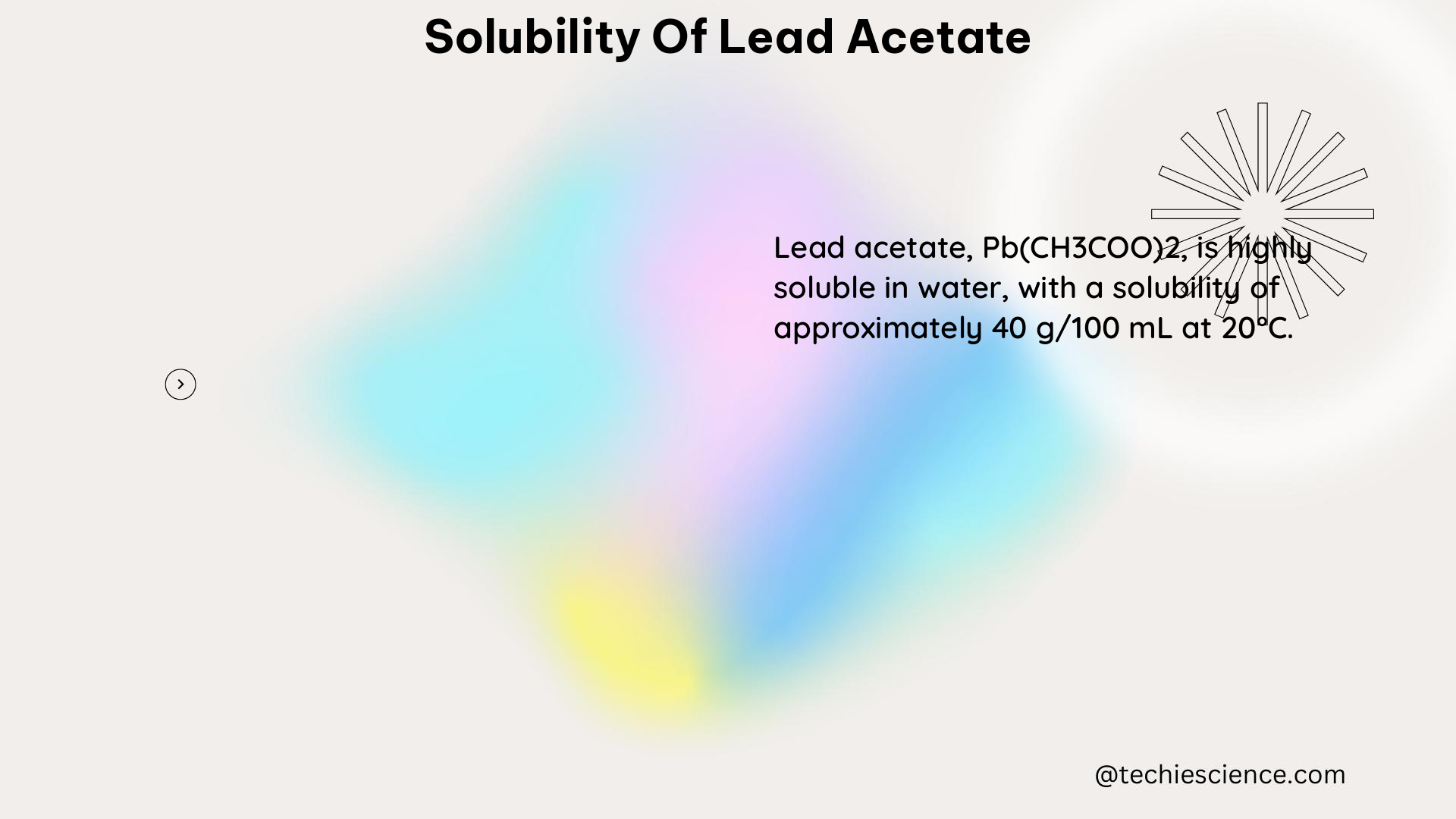Summary
Lead acetate, also known as lead diacetate or plumbous acetate, is a highly soluble white to gray crystalline solid with the chemical formula Pb(CH3COO)2. Its exceptional solubility in water makes it a valuable compound in various applications, including as a reagent in chemical reactions and as a standard solution in analytical chemistry.
Understanding the Solubility of Lead Acetate

Quantifying Solubility
At 20°C, the solubility of lead(II) acetate in water is 44.3 g/100 mL. This value represents the maximum amount of lead acetate that can be dissolved in water at this temperature to form a saturated solution. To calculate the molar concentration of a saturated solution at this temperature, we need to know the molar mass of lead(II) acetate, which is approximately 325.2 g/mol. Using the given solubility value and the molar mass, the molar concentration of a saturated lead acetate solution at 20°C would be around 0.136 M.
Factors Affecting Solubility
The solubility of lead acetate in water is influenced by several factors, including temperature, pH, and the presence of other ions or compounds in the solution. As the temperature increases, the solubility of lead acetate generally increases, following the general trend of increased solubility with higher temperatures. However, it is important to note that the solubility of lead acetate can also be affected by the pH of the solution, as the speciation of lead ions can change with varying pH conditions.
Solubility Equilibrium
The dissolution of lead acetate in water can be represented by the following equilibrium reaction:
Pb(CH3COO)2(s) ⇌ Pb2+(aq) + 2 CH3COO-(aq)
At equilibrium, the concentrations of the dissolved species (Pb2+ and CH3COO-) are related to the solubility product constant (Ksp) of lead acetate, which is approximately 2.5 × 10-13 at 25°C. The Ksp value provides a quantitative measure of the solubility of lead acetate in water, and it can be used to calculate the concentrations of the dissolved species at equilibrium.
Solubility Calculations
Using the solubility of lead acetate (44.3 g/100 mL at 20°C) and its molar mass (325.2 g/mol), we can calculate the molar concentration of a saturated lead acetate solution:
Molar concentration = Solubility (g/100 mL) / Molar mass (g/mol)
Molar concentration = 44.3 g/100 mL / 325.2 g/mol
Molar concentration ≈ 0.136 M
This molar concentration represents the maximum amount of lead acetate that can be dissolved in water at 20°C to form a saturated solution.
Solubility Product Constant (Ksp)
The solubility product constant (Ksp) for lead acetate is approximately 2.5 × 10-13 at 25°C. The Ksp value can be used to calculate the concentrations of the dissolved species (Pb2+ and CH3COO-) at equilibrium, as well as to determine the solubility of lead acetate under different conditions.
The Ksp expression for lead acetate is:
Ksp = [Pb2+] × [CH3COO-]2
Using the Ksp value and the known solubility of lead acetate, we can rearrange the Ksp expression to solve for the individual ion concentrations at equilibrium.
Solubility and pH
The solubility of lead acetate can be affected by the pH of the solution. In acidic conditions (low pH), the solubility of lead acetate may increase due to the formation of soluble lead-containing species, such as Pb2+ ions. Conversely, in basic conditions (high pH), the solubility of lead acetate may decrease due to the precipitation of lead hydroxide or other lead-containing compounds.
It is important to consider the pH-dependent solubility of lead acetate when working with this compound, as it can have implications for its behavior and applications in various chemical systems.
Preparation of Lead Acetate Solutions
From a DIY perspective, you can prepare a lead acetate solution by dissolving lead acetate trihydrate (Pb(CH3COO)2·3H2O) in water, adding acetic acid (CH3COOH), and diluting to the desired volume. This process allows you to create a standard solution for various applications, such as chemical analysis or as a reagent in other reactions.
It is crucial to follow appropriate safety guidelines when handling lead acetate, as it is a toxic compound. Proper personal protective equipment (PPE) and containment measures should be used to minimize exposure and potential health risks.
Conclusion
In summary, lead acetate is a highly soluble compound in water, with a solubility of 44.3 g/100 mL at 20°C. This solubility value, along with the molar mass of lead acetate (325.2 g/mol), allows us to calculate the molar concentration of a saturated lead acetate solution, which is approximately 0.136 M.
The solubility of lead acetate is influenced by various factors, including temperature, pH, and the presence of other ions or compounds in the solution. Understanding the solubility characteristics of lead acetate is crucial for its safe handling and effective use in various applications, such as chemical reactions and analytical chemistry.
References
- Lead Acetate – an overview | ScienceDirect Topics. (n.d.). Retrieved from https://www.sciencedirect.com/topics/pharmacology-toxicology-and-pharmaceutical-science/lead-acetate
- lead acetate anhydrous | C4H6O4Pb | CID 9317 – PubChem. (n.d.). Retrieved from https://pubchem.ncbi.nlm.nih.gov/compound/9317
- The solubility of lead(II) acetate at 20 oC is 44.3 g/100 mL. From this information, calculate the molar concentration of a saturated solution. (n.d.). Retrieved from https://www.coursehero.com/tutors-problems/Chemistry/28362714-Thesolubilityof-leadII-acetate-at-20oC-is-443-g100-mL-From-this-i/

The lambdageeks.com Core SME Team is a group of experienced subject matter experts from diverse scientific and technical fields including Physics, Chemistry, Technology,Electronics & Electrical Engineering, Automotive, Mechanical Engineering. Our team collaborates to create high-quality, well-researched articles on a wide range of science and technology topics for the lambdageeks.com website.
All Our Senior SME are having more than 7 Years of experience in the respective fields . They are either Working Industry Professionals or assocaited With different Universities. Refer Our Authors Page to get to know About our Core SMEs.